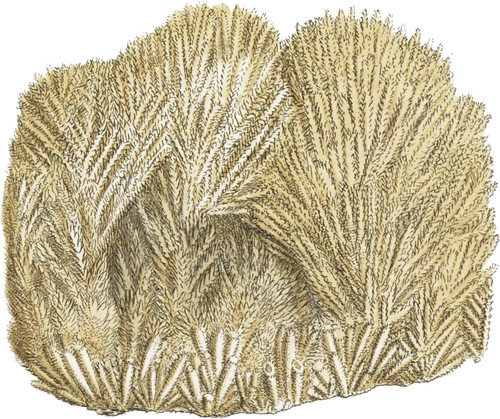 Enlarge
Enlarge
British Mineralogy
Arborescent Carbonate of Lime
- Div. 2. Imitative.
The peculiar appearance of these specimens of Carbonate of Lime, from Alstone Moor in the county of Durham, is particularly interesting. Specimens were in Mr. Day’s collection; and I have received large ones from the late Hon. Charles Greville. My worthy friend Philip Rashleigh, esq. considered it as representing feathers: see his plate 25, f. 2. The rather pinnate appearance certainly gives it an apt resemblance; but it is frequently more arborescent, yet flattish; something like the Juniper. It is rather peculiar to itself, and requires to be seen to be understood: the figure, however, will give a tolerable idea of it; and it cannot fail to be recognized from the singularity of its structure, although it varies a little. The lower parts are crystallized in a sort of spiculæ, not unaptly resembling a barley-corn, but somewhat triangular; sometimes smaller, sometimes larger; the larger ones covered laterally with evidently three-sided pyramids a little rounded; such as these more or less flattened, grouping, spreading and inosculating, produce the shrub-like form; and often, from the lower part spreading least and the upper part most, produce a sort of Gothic arch. The top of the shrub, as it were, is surmounted by a new series more or less confused, but depending upon a similar structure. It is found in large masses of afoot or more in diameter and six or eight inches high.
These elegancies of Nature may be very instructive in decorative architecture, and produce some originality; as it must be owned that, however high the present age stands in that science, it is more borrowed from our ancestors’ borrowings than from Nature herself.

